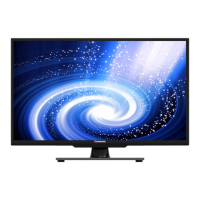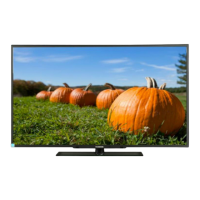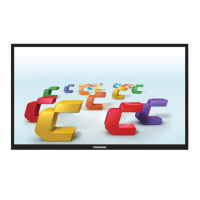
Do you have a question about the Changhong Electric UD55GHE6000Ai and is the answer not in the manual?
| Brand | Changhong Electric |
|---|---|
| Model | UD55GHE6000Ai |
| Category | LED TV |
| Language | English |
Guidelines for safely installing the LED screen, avoiding physical damage and proper handling.
Precautions for operating the TV, including power cable handling and avoiding image retention.
Recommendations for storing the TV, specifying temperature and humidity ranges for optimal preservation.
Important considerations for disassembling the TV, focusing on protecting sensitive components and screw management.
A critical warning about the high-voltage generated by the power supply board and the risk of electric shock.
Details the general specifications and standards for the TV, covering functions, inputs, and environmental requirements.
Identifies and describes various input/output terminals on the TV's mainboard with practical images.
Lists the main integrated circuits on the HLS71EJ-IU chassis and their primary functions, including voltage regulators and amplifiers.
Specifies the recommended operating conditions, including voltage and temperature ranges for the MSD6586 chip.
Provides a brief introduction to the MSH6110A chip, detailing its pin functions and role as a DC-DC converter.
Introduces the SY8089AAAC chip, outlining its pin functions and purpose in power supply management.
Details the pin functions and electrical characteristics of the TPS562201 power management IC.
Outlines the pin functions and specifications for the TPS563201, another power management integrated circuit.
Describes the TPA3136D audio amplifier chip, including its pin assignments and functions.
Provides an overview of the R842 tuner, detailing its operating parameters and pin functions.
Introduces the power supply system of the TV, mentioning its output voltages.
Illustrates the power block diagram, showing how different voltage rails are distributed across the mainboard.
Details the pin voltages for various voltage adjustors located on the TV's mainboard.
Defines the various interface connectors on the mainboard, explaining their purpose and pinouts.
Presents two primary methods for upgrading the TV's software, outlining the general approach for each.
Details the first method for software upgrade, specifically using USB Tools, noting it's not recommended.
Explains the recommended method of upgrading software using a USB drive with the program file.
Details the steps for upgrading the main program via USB, including file preparation and insertion.
Provides instructions for updating specific firmware components like MAC address, HDCP keys, and CI PLUS keys.
Addresses troubleshooting steps for a TV that does not power on, suggesting basic connection checks.
Offers a troubleshooting guide for common TV issues like no picture, no sound, or distorted display.
Details how to access and navigate the initial menu within the factory mode settings.
Describes options within the factory selection menu for product and panel configurations.
Explains how to access and view system information, including network tests and MAC address settings.
Covers settings related to TV tuning, color systems, sound systems, and tuner configurations.
Details options for adjusting audio settings such as volume and balance.
Outlines parameters related to design mode, including power-on behavior and white balance.
Describes settings for SSC (Serial Serial Communication) related functions, including LVDS and memory configurations.
Information regarding default settings and factory reset options.
Details settings for controlling the display backlight.
Covers settings for energy detection and picture quality debugging.
Information related to Digital TV functions, including CI info and resource management.
Settings related to the user interface and system communication.
Details host service settings and specific application support options.
Points to the appendix containing the circuit schematic diagram for detailed technical reference.







